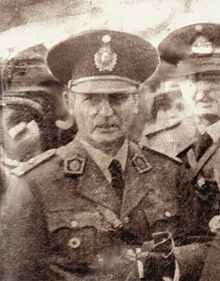Arturo Rawson
This articleneeds additional citations forverification.(January 2013) |
Arturo Rawson | |
|---|---|
 | |
| President of Argentina | |
| In office June 4, 1943 – June 6, 1943 | |
| Appointed by | Military junta |
| Vice President | None |
| Preceded by | Ramón Castillo |
| Succeeded by | Pedro Pablo Ramírez(de facto) |
| Personal details | |
| Born | June 4, 1885 Santiago del Estero |
| Died | October 8, 1952(aged 67) Buenos Aires |
| Nationality | Argentine |
| Political party | Independent |
| Spouse | Delia Sixta Borda (1895–1983) |
| Profession | Military |
Arturo Rawson(June 4, 1885 – October 8, 1952) was anArgentinepolitician, military officer, and the provisionalPresident of the Republicfrom June 4, 1943, to June 6, 1943.[1][2][3]
His coup started a series which culminated in the accession to power of theLabor Partyjust 3 years later.[citation needed]
Biography[edit]
Rawson was born inSantiago del Esteroin 1885 to aSan Juanfamily ofAmericanorigin.[4][5]Through his grandfatherJuan de Dios Rawson,he was related toGuillermo Rawson.Rawson attendedArgentina’s Military College, which he graduated from in 1905[3]and subsequently taught at for a time. Rawson rose through the ranks of theArgentine Armyand was eventually promoted togeneral.By 1943, Rawson was the Commanding Officer ofCavalryat Campo de Mayo.[citation needed]On June 3, 1943, Rawson was contacted by members of the GOU (United Officers' Group), a group of military officers planning to overthrow Argentina's civilian government. The GOU, lacking the sufficient number of troops needed to successfully implement acoup,knew Rawson could provide the soldiers they required. Rawson, who had been scheming to overthrow the government even before he was contacted by the GOU, agreed to their plan. On June 4, Rawson and 10,000 troops under his command enteredBuenos Airesand overthrew the government ofRamón Castillo.This ended the historical period known as theInfamous Decadeand started theRevolution of '43.
Rawson promptly declared himselfpresident of Argentinathe same day, beatingPedro Pablo Ramírezto do so.[6]However, his choices for hiscabinetalienated the GOU leadership, who forced him to resign on June 7. Rawson, as Castillo did, supported theAllies of World War II,but the bulk of the military that organized the coup wanted Argentina to stay neutral in the conflict, considering that joining the war would prove destructive for the country. Colonel Elbio Anaya appeared at his office and told him that he was ruling because of a misunderstanding, as the president was Ramírez. Rawson resigned, and rejected the military escort, leaving theCasa Rosadaon a military jeep. His time as president was so brief that he never actually made theOath of office.Even so, he did not take power as aninterim president,but expecting to rule for a long time.[7]Thus, Rawson has had the second shortest mandate of any Argentine president, and the shortest mandate of any Argentine non-acting president, holding the office for just three days (the first beingFederico Pinedowith 12 hours).[6]
After resigning as president, Rawson was appointedAmbassadortoBrazil,a post he would hold until 1944.[3]He congratulated Ramírez when he broke relations with Germany and Japan.[8]In 1945, Rawson was arrested and brought before amilitary tribunalfor opposing the government of PresidentEdelmiro Farrell,but he was quickly released. In September 1951, Rawson supported GeneralJosé Benjamín Menéndez’s failed attempt to overthrow the government ofJuan Perón,for which Rawson was temporarily imprisoned. He wrote the bookArgentina y Bolivia en la epopeya de la emancipación(literally "Argentina and Bolivia in the Liberation epic" ). Rawson died of aheart attackin Buenos Aires in 1952. He is buried atLa Recoleta Cemeteryin Buenos Aires.
See also[edit]
Bibliography[edit]
- Mendelevich, Pablo(2010).El Final.Buenos Aires: Ediciones B.ISBN978-987-627-166-0.
References[edit]
- ^"Argentina | History, Facts, Map, & Culture".Encyclopedia Britannica.Retrieved2018-08-18.
- ^"Biografia de Arturo Rawson".2016-03-04. Archived fromthe originalon 2016-03-04.Retrieved2018-08-18.
- ^abcTheBiography.us."Biography of Arturo Rawson (1884-1952)".Archived fromthe originalon 2018-08-18.Retrieved2018-08-18.
- ^"Biografia de Arturo Rawson".biografiasyvidas(in Spanish).Retrieved2018-08-18.
- ^"Amán Rawson Hull b. 1794 Montague, MA, Estados Unidos d. 11 Jan 1847 San Juan, San Juan, Argentina: Genealogía Familiar".2015-10-03. Archived fromthe originalon 2015-10-03.Retrieved2018-08-18.
- ^abMendelevich, p. 144
- ^Mendelevich, p. 145
- ^Mendelevich, p. 146

